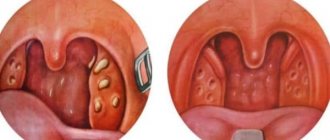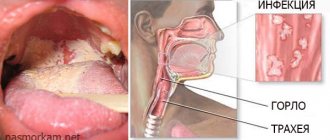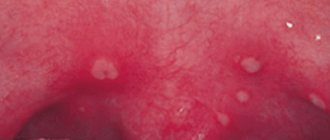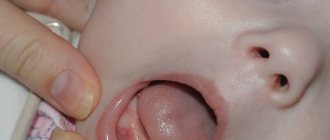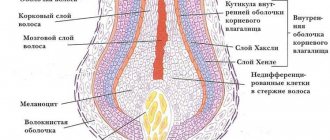Why is there a problem?
Next, we consider the main pathological conditions of the oral cavity, which are accompanied by the appearance of sores.
Systemic pathologies
Ulcerative lesions of the oral mucosa in adults and children can be symptoms of various diseases. Thus, one of the “culprits” of such formations is tuberculosis - soft tissues are covered with multiple mounds, which over time increase in size and turn into ulcers (they hurt, burn, react to hot and cold food). Additional signs:
- loss of appetite, weight loss;
- yellowish-white coating on the gums and tongue;
- hyperthermia (up to 39 degrees);
- hyperhidrosis.
Syphilis of the oral mucosa “makes itself known” as painless, red, round ulcerations with a grayish coating on the surface. Acute necrotizing gingivostomatitis is a viral disease; ulcers form not only on the gums, but also on the tonsils, cheeks, and tongue. Cancer is the most serious cause of numerous mouth ulcers. When pressed, such formations do not hurt, have fuzzy thick edges, and do not heal for a long time.
Various forms of stomatitis “attack” the oral mucosa with reduced immunity
It is noteworthy that ulcers and ulcers can be the result of banal vitamin deficiency. So, to normalize the condition of the mucous membrane, it is necessary to add to the daily diet foods high in vitamin P (plums and apples, nuts, liver), group B (peas, corn, beef, eggs, parsley, oatmeal), C (currants, grapes, rose hips) , A (carrots, onions, apricots, peaches).
Dental diseases
White sores in the mouth are usually a symptom of stomatitis, an infectious disease that attacks an organism with reduced immunity. What spots appear on the roof of the mouth are determined by the type and form (acute, chronic) of the disease.
So, stomatitis can be:
Aphthae in the mouth
- aphthous (multiple white sores on the oral mucosa, painful ulcers with clearly defined boundaries);
- aphthous recurrent (white spots appear in the mouth of an adult and a child, with even minor mechanical trauma to such formations, ulcers appear - aphthae);
- herpetiformis (the mucous membrane is abundantly strewn with painful itchy spots that are visually similar to herpes; most often the disease affects the fairer sex under the age of 30);
- fungal (there is a white coating on the soft tissues, the causative agent is usually Candida fungus);
- ulcerative (one or more sores appear in the mouth, ulcers on the tongue, lips, cheeks - the result of untreated catarrhal stomatitis in a timely manner).
If the gums in the interdental space are covered with ulcers, we are talking about ulcerative gingivitis (inflammatory process). The mouth and throat may also become ulcerated after radiation or chemotherapy. There is also such a disease as recurrent necrotizing periadenitis (Setton's aphthae) - characteristic compactions form in the oral cavity, they are painful when pressed, then open ulcers form, from which infiltrate flows.
The “culprits” of sores in the mouth, as a rule, are dental diseases of an infectious-inflammatory nature.
Important! The reasons for the appearance of white spots on the lip, cheek and tongue are injuries to the mucous membrane of rough food, biting soft tissues during chewing, and excessively intensive brushing of teeth. Often the occurrence of such formations entails dental treatment. A child may develop ulcers in the mouth due to the harmful habit of thumb sucking (the so-called Bednar aphthae). With such an anomaly, yellowish dots appear on the mucous membrane, located on the palate.
Causes of white plaque and spots on the sky
There are several main causes of the symptom.
Stomatitis
An inflammatory process that affects the mucous membranes of the oral cavity. It appears as redness, which will develop into a single white ulcer. Occurs due to:
- Vitamin deficiency.
- Using products containing sulfate .
- Microbes.
- Smoking.
- Lack of personal hygiene.
- Taking medications that reduce salivation.
With stomatitis, the patient experiences severe pain. The gums begin to bleed and an unpleasant odor appears.
Candidal stomatitis
Another name for the disease is oral thrush. The causative agent is the diploid fungus Candida Albicans, which is constantly present in the mucous membrane. With a weakened immune system, it begins to multiply, which is why a white coating of a cheesy substance appears on the palate.
- Unpleasant sensations while eating.
- Dry mouth.
- Arrivals in the corners of the lips.
By removing plaque yourself, the source of inflammation is released. If the disease is not treated and the spots are not removed, then erosion will form in these places.
Aphthous stomatitis
The exact reasons why it occurs have not been established. Doctors believe that this is an infectious or viral disease. It appears in the form of round plaques of a milky or yellowish color with a red rim. Possible factors of occurrence:
- Lack of vitamin C, B.
- Lack of microelements: iron, selenium, zinc.
- Disruption of the digestive system of organs.
- Allergy.
- Weakened immunity.
- Injuries to the oral mucosa.
- Burn.
Due to aphthous stomatitis, the patient experiences discomfort. It is more common in people between 20 and 40 years old.
Lichen planus
Despite the name, this disease appears as light, spider-like spots. Causes:
- Weakened immunity.
- Mechanical damage in the oral cavity.
- Allergic reaction to medications.
- Stress, depression, physical or psychological fatigue.
Leukoplakia
A dangerous disease that is defined as precancerous. Causes pathological changes in the mucosa, in which a white coating and thread-like formations of a gray-white hue appear. Frequent causes of formations:
- Smoking.
- consumption .
- Mechanical damage to the oral cavity.
- Eating food that is too cold or hot.
- Genetic predisposition.
- HIV AIDS.
- Negative environmental factors .
- Lack of iron, vitamin A.
- Diabetes .
The disease does not cause severe discomfort. But if leukoplakia is detected, treatment must be started immediately.
Tonsillitis
Infection. It often develops into a chronic form, as it is difficult to fix in the initial stages. Signs:
- White spots on the palate and tonsils.
- Constant sore throat.
- Difficulty swallowing.
- Unpleasant smell.
- The appearance of pus from the tonsils.
- Swollen lymph nodes.
- Increased fatigue.
- Fever .
Symptoms and diagnosis
Aphthous stomatitis is localized under the lower lip, on the tongue and cheeks, at the base of the gums (as in the photo). Ulcers are small, red tumors that swell and subside during the day. When such formations resolve themselves, their surface is covered with a yellow or white crust, the edges of the ulcers are clearly defined and inflamed. Symptoms with this form of stomatitis heal within 2 weeks, leaving no scars on the mucous membrane. General symptoms are rarely disturbing; one or more ulcers may appear on the mucous membrane at a time.
Causes of multiple white spots in the mouth
There are many different reasons for the appearance of white, painful spots in the infected oral cavity of a person. It is impossible to independently recognize whether neoplasms in the oral cavity are a symptom of any disease. Delays in contacting a doctor can lead to unpleasant or dangerous consequences.
Diseases
Candidal stomatitis or thrush is a common disease that causes the appearance of multiple white spots on the oral mucosa. The disease is of fungal origin. There are several ways of infection: from mother to newborn child, through direct contact with a carrier of infection, through household items.
Lichen planus is a disease of the skin and mucous membranes. Has an unknown etiology. When white dots appear in the oral cavity, it mainly affects the red border of the lips and tongue. In most patients, the disease manifests itself as milky papules with a rough surface. The formations are connected to each other by bridges. A person complains of pain while eating, a burning sensation, and dryness.
Acute tonsillitis or purulent tonsillitis. A disease of a bacterial nature. The disease is accompanied by fever, swollen lymph nodes, sore throat, and cough.
Solution
How can you cure mouth sores at home? Traditional medicine offers a lot of useful recipes that can be used to independently combat the symptoms of local diseases. It is important to understand that such measures will not demonstrate any effect if the painful formations are secondary (a consequence of systemic pathologies).
Mouth ulcers are one of the symptoms of syphilis
So, you can anoint an ulcer in the mouth with a paste of baking soda (a small amount of powder is mixed with a few drops of water). The soda solution is also suitable for rinsing - they are done throughout the day (every 2-3 hours and immediately after meals) until the ulcers heal. Aloe vera extract will help get rid of painful ulcers due to stomatitis - it is applied to the formations 2-5 times a day.
Take 1 tbsp. l. dried calendula flowers are steamed with 250 ml of boiling water, and the resulting mixture is kept on low heat for another 10 minutes. The cooled decoction is used for medicinal rinses (it has anti-inflammatory, soothing, wound-healing properties).
After consultation with a dentist, in order to cope with unpleasant symptoms, you can take systemic antiallergic drugs (Tavegil, Loratadine, Suprastin). In addition, the ulcers are treated with gel with Lidocaine and Dexamethasone, and the mouth is rinsed with pharmaceutical antiseptic solutions. For herpetic stomatitis, the rashes are lubricated with Acyclovir and other antiviral compounds.
What else to do to combat stomatitis on your own:
- apply sea buckthorn oil, a mixture of sour cream with chopped garlic and onion to the affected areas;
- Brew a tea bag, place it in the refrigerator, and after half an hour apply it to the ulcerated areas of the mucous membrane.”
- combine the contents of two ampoules of vitamin B12 and one ampoule of Dexamethasone, add to them 2 Nystatin tablets, ground to a powder. Cotton swabs are moistened in the finished medicine and applied to painful areas in the mouth.
The fight against sores in the mouth is complex, including local antiseptics, anti-inflammatory drugs, rinses and applications
Before eating, it is recommended to rinse your mouth with cool water to reduce discomfort when food particles get into the inflamed mucosa. During treatment, it is recommended to avoid sour, spicy, excessively sweet and salty foods, and drink natural, non-acidic fresh juices.
Red spots
If red and white spots appear on the face, it means that there is some kind of disorder in the body. Lifestyle is of great importance. Anything that comes into contact with the skin and enters the body through the stomach can cause unpleasant growths. Problems may be caused by:
- Allergies to cosmetics, food, medications, etc.
- Skin diseases - eczema, dermatitis, lichen, psoriasis.
- Active work of the sebaceous glands, acne.
- Hormonal changes during pregnancy, childbirth, and the menstrual cycle.
- Taking powerful medications.
- Adverse weather conditions.
- A rush of blood to the skin due to nervous tension, physical activity, temperature changes.
- Cosmetological facial cleansing.
If any unusual rashes appear, you should understand what caused them. Sometimes, to solve a problem, it is enough to change your lifestyle, adjust your diet, or change your cosmetics.
Prevention
To avoid purulent and ulcerative formations on the oral mucosa, it is recommended to visit the dentist in a timely manner, follow basic rules for caring for teeth and gums at home, and avoid excessively hot and cold drinks (food). Strengthening the immune system, a healthy diet and regular physical activity, coupled with psycho-emotional stability, will also help prevent the occurrence of this problem.
So, the appearance of various formations on the oral mucosa can be caused not only by infectious and inflammatory dental diseases, but also by problems within the body. The main “culprit” of white sores in the mouth is considered to be stomatitis, which “attacks” the mucous membrane with reduced immunity. Vitamin deficiency, syphilis, tuberculosis, cancer are systemic pathological causes of rashes. Treatment depends on why the ulcerated areas or ulcers appeared. The dentist should select medications and procedures.
What can white spots in the mouth indicate?
White spots in the mouth can appear on the mucous membrane of the tongue, gums, and the inside of the cheeks. Such rashes are harmless in nature, but in some cases they indicate the onset of a pathological process. Sometimes neoplasms do not cause significant discomfort, which leads to refusal of a medical examination. To find out whether a single white point poses a threat, you need to understand the features of the phenomenon.
